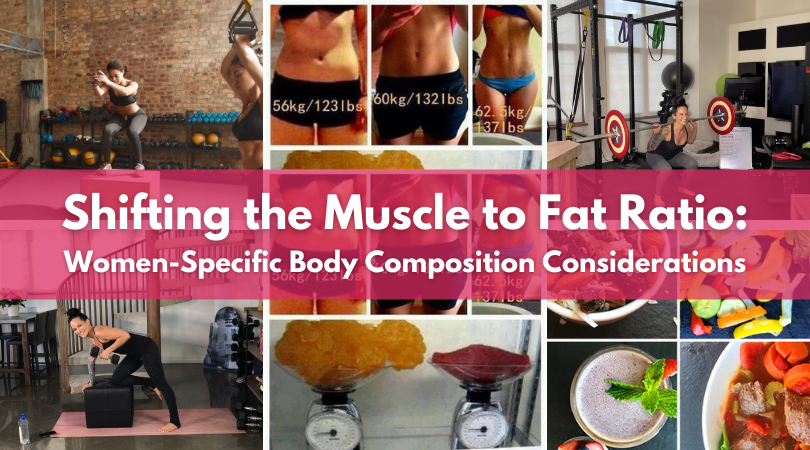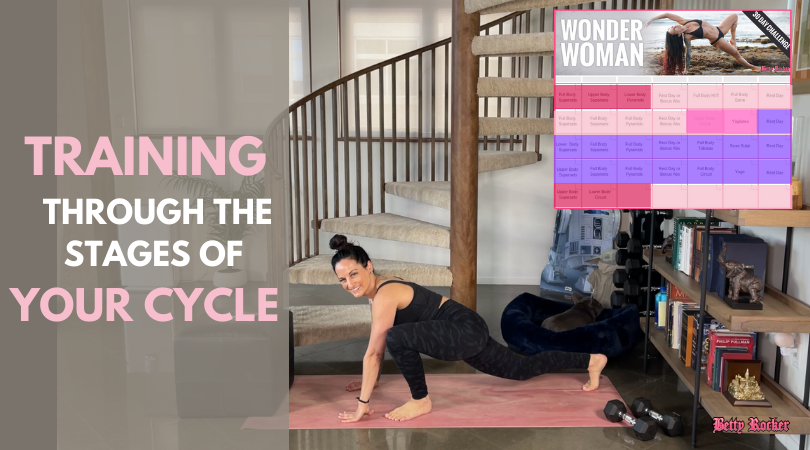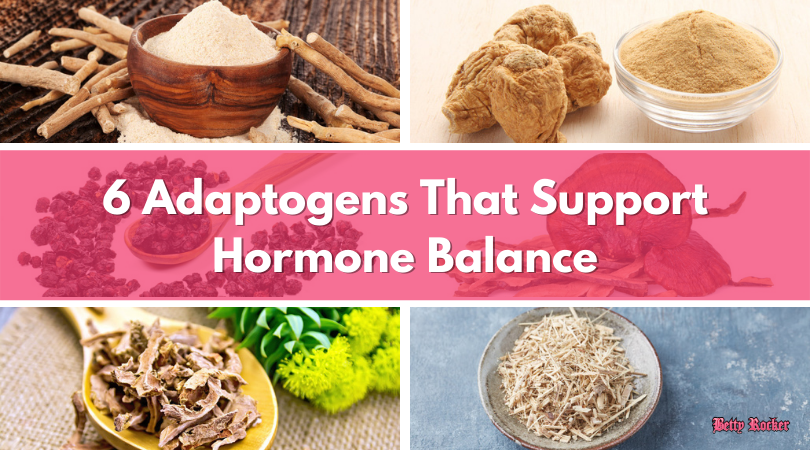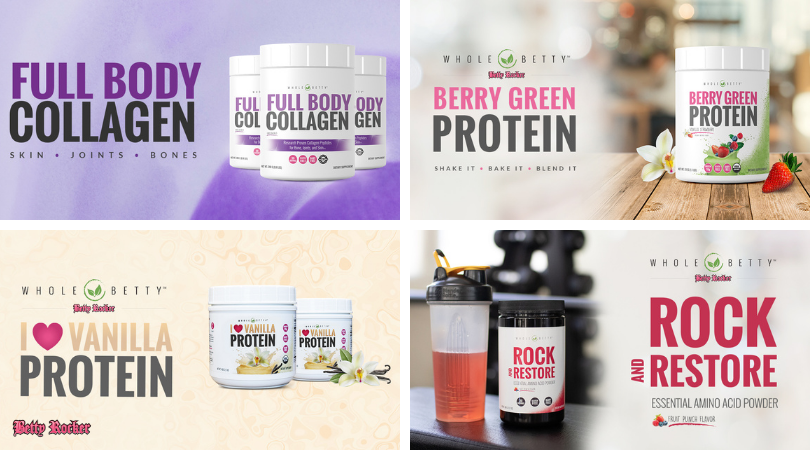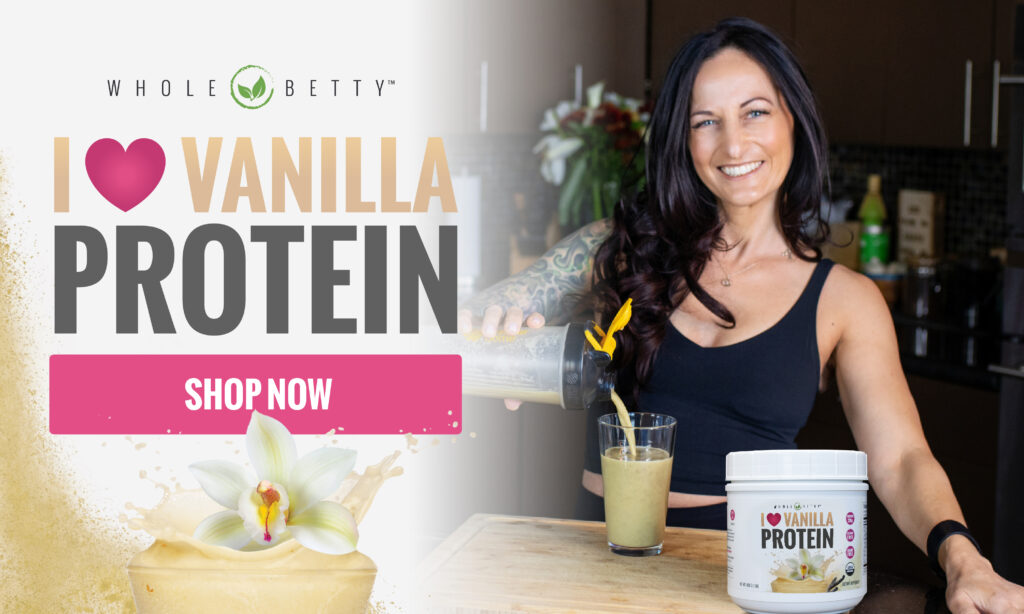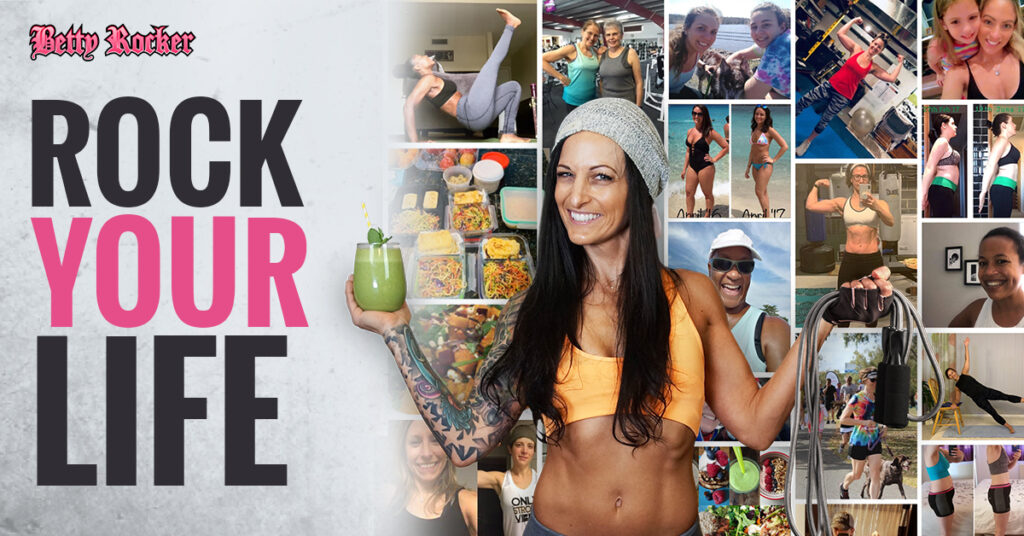In this article (clickable table of contents):
- I. The research has been skewed and gender biased for too long
- II. Common issues I hear women struggle with – do any of these apply to you?
- III. Understanding that body composition is NOT “your weight on the scale”
- IV. Creating an optimal state in the body to drive the results you want
- V. Building muscle and losing fat at different stages of your menstrual cycle
- VI. Building muscle and losing fat for women in peri and post menopause
- VII. For women of all ages: why we need to eat balanced meals with whole foods
- VIII. The importance of fueling (not fasting) around your workouts and how to do it
- IX. Why reduced stress and quality sleep are also essential for body composition shifts
- X. Wrap up and recommendations for additional learning
I. The research has been skewed and gender biased for too long
Many women I talk to are still subscribing to outdated myths about training and are stuck in an “exercise more, eat less” mentality that is robbing them of the strong, healthy body they deserve from the effort and time they put into their training.
I want to clarify from the start of this article that I’m aware of and respect that people have different goals for their physique and different lifestyle practices they are comfortable with, and that what I am focused on in this post is helping you better understand how your body works so you can become physically stronger, more capable and confident, and enjoy a high quality life in a functional body at every age.
It’s time to bust some myths and give you the information you need to support your body’s process of getting stronger and healthier so you can stop undermining all the effort you put in with diet culture myths or strategies that come from research done on men, not women.
The changes we go through in life in our incredible female bodies – from puberty to menopause and everything in between – deserves attention and understanding. We are often on our own figuring everything out with so much scientific research in the past being done on men only, and the perception of a woman’s cycle as “too complex” (1).

This gender biased research means many (fortunately not all) doctors and other professionals fail to address women’s hormone concerns adequately, dismiss their concerns entirely by suggesting “it’s just part of the aging process” or “it’s in your head” or suggest strategies that fail to address the root cause of the issues.
When researching this post for example, I found the lack of female representation in research studies appalling. It is only in recent years that women have been included more frequently, and yet even in many of the studies that included women there was rarely any differentiation in phases of the menstrual cycle, or attention to women at different stages of life. And even less that examined women of different cultures and ethnicities to explain how women from different backgrounds might experience things like peri menopause, strength gains and fueling needs.
As a result, generalizations are made because of the design of the research studies. No wonder it has been challenging for us to get good, relevant information that works for us! I will present to you what I have learned from what is currently available, but I too am still looking for more. See recommendations for follow up at the end of this article.
II. Common issues I hear women struggling with – do any of these apply to you?
- “I eat healthy but I’m not losing weight.” Over focusing on “weight loss” without understanding body composition can skew your perception of results.
- “I am super low carb, but I keep having sugar cravings.“ Low carb diets create eating imbalances and metabolic disruption in active women.
- “I’m afraid to take rest days, but I am starting to feel less motivation.” Overtraining leads to low energy and heightened inflammation.
- “I do an extra hour of cardio after my other workout but I still am not getting leaner.” Overtraining and excess cardio can increase inflammation, elevate cortisol, lead to muscle breakdown, and impact metabolic health.
- “I do fasted training every day, but I’m still not seeing results.” Women do better in a fed state than a fasted state with their workouts.
- “I just went through menopause and I’ve gained 15-20 pounds.” Lack of understanding of how to adjust training and nutrition strategies in this life stage leads to increased fat gain and loss of muscle.
III. Understanding that body composition is NOT “your weight on the scale”
Due to over-focus on “weight loss” many women are more focused on seeing a scale number go down rather than on how they can lose body fat and increase lean mass (2)(3).
If we take a closer look at body composition, we can shift this mentality and start to understand why even when we sometimes lose “weight” doing fad diets it comes right back, and that we’re sacrificing our valuable muscle tissue in an effort to lose this “weight”(4).
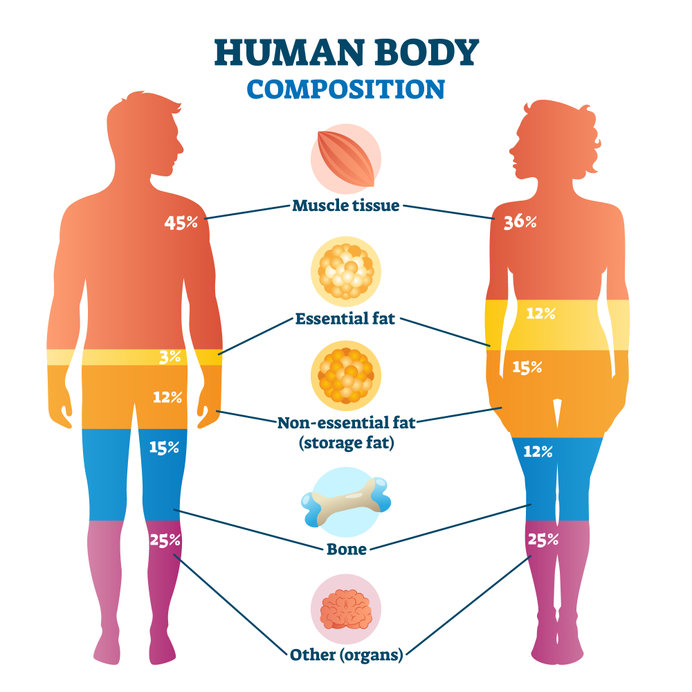
Weight on the scale measures overall body weight, which includes muscle, bone, water at the time of weighing, body fat and all the body tissues combined. Because many of these factors are variable (have you eaten, how much water are you retaining, what time of the month is it, have you had a bowel movement today), it’s more ideal to measure the composition of fat and muscle tissue on the body rather than body weight alone, which does not take the ratio of these important tissues into consideration.

Two women, one with more muscle and less fat and one with more fat and less muscle might weigh the exact same number on the scale. But the woman with more muscle will look leaner and more compact, and the woman with more body fat will look thicker.
While a pound of muscle and a pound of fat both weigh one pound, the pound of fat takes up more space than the pound of muscle, due to its structural composition.
This is why taking a closer look at the ratio of muscle to fat on your body matters far more than the “amount you weigh.”
To get a real body composition measurement, ideally you would use a professional method like the DXA scan (dual x ray absorptiometry), air displacement plethysmography (i.e “Bod pod“), bioelectrical impedance measurement (i.e. InBody scan or similar), 3-D body scanner, or other professional body composition measuring test.
However as these are not always readily available, other methods may be useful for self testing, including skin caliper measurements, measurements with a tape measure around the hips, thighs, arms, stomach and chest, and full length photos from the front, side and back wearing the same or similar garments.
While it’s absolutely fine to weigh yourself in addition to these methods when looking for changes, only weighing yourself will give you very little data that speaks to your body composition. Combined with an over focus on “weight loss” along with the cultural expectations of women and their bodies, many women have disordered eating (5), disordered self perception, and are following fad diets, skipping meals, under-eating and overtraining.
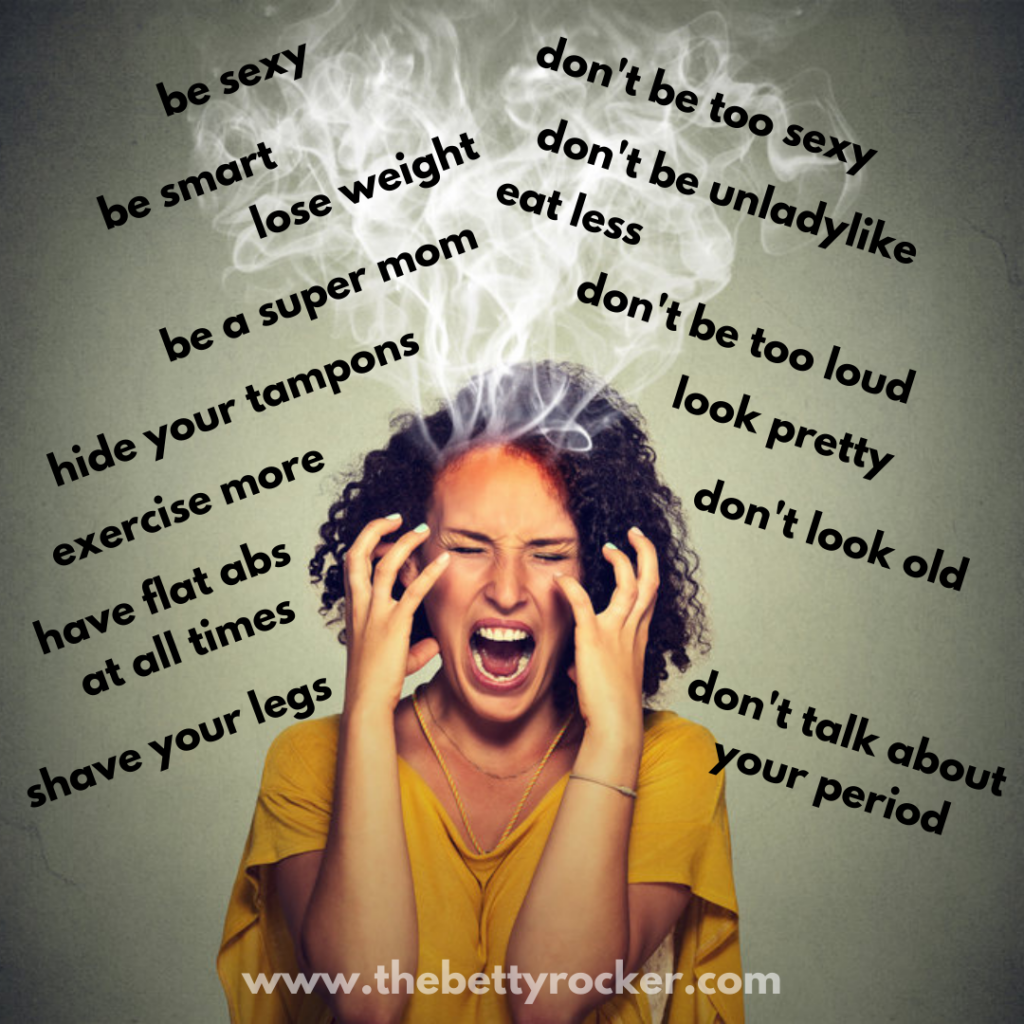
They end up constantly down on themselves for their perceived lack of progress, under nourished, stressed-out and set themselves up for unintended health consequences including an increased risk for bone stress injury and cardiovascular disease (6).
This heightened stress state from overtraining and under fueling (not to mention stressing about our weight and every other pressure we feel from societal expectations) elevates our cortisol and increases the inflammatory response, which not only breaks down muscle but also creates fat storage and has a detrimental impact on our mood, energy levels, and long-term metabolic rate and overall health (7).
While some “weight loss” may be observed, this often comes back quickly, and the manner in which the weight is lost has unintended consequences that do little to contribute to a highly functional, strong body. All this focus on our weight and the vicious cycle we get in when we constantly seek shortcuts to lose it can undermine our long-term health and a good quality of life, increase negative self talk, and contribute to the perception that our appearance is the main driver of our value and worth.
While fat loss is a goal that a lot of women have and equate to “weight loss,” not enough women have the goal of gaining or preserving muscle, and as a result they are losing out – especially during the important transition from regular menstruating years to peri and post menopause – a time when the body’s fluctuating estrogen and progesterone signals become irregular and eventually stop, impacting our ability to lose fat and build muscle the same way.
The reason I say we as women are losing out is because muscle is metabolic currency (8). When we focus on strengthening, growing and preserving our muscle tissue, we start training, eating and resting in smarter ways, ways that go beyond aesthetics and support our long-term health – and as an added bonus, frequently have an aesthetic result as a natural byproduct.
I discussed this in depth, along with the ramifications this has on women in a recent podcast with Dr. Stacy Sims, and Rock Your Life member Amanda had this to say about how it impacted her:
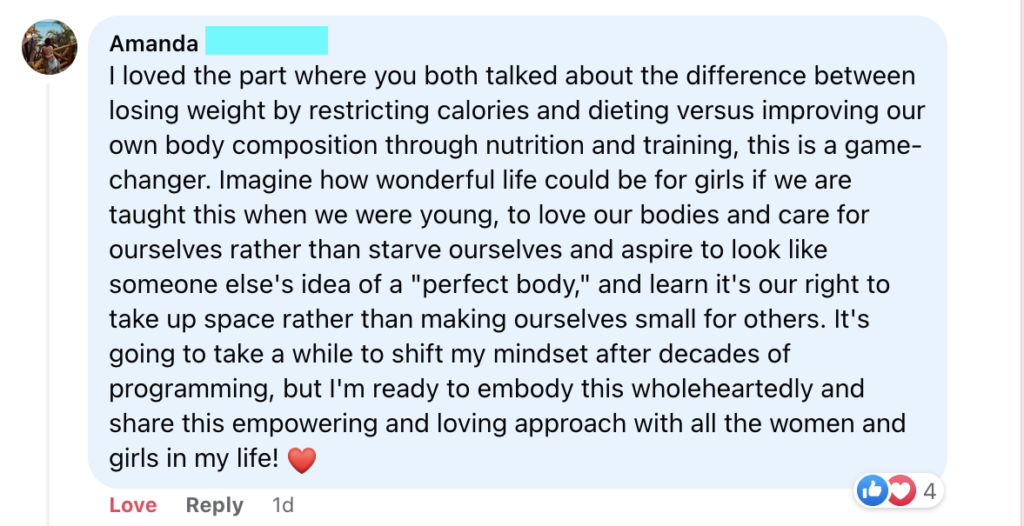
Understanding body composition and setting goals with that as a primary focus rather than on weight loss is truly a mindset game changer.
As Amanda points out, this unhealthy focus on having someone else’s idea of a “perfect body” is one of the root causes of the problem that creates so much stress and pressure on women. I want to thank the Rock Your Life members for all the discussions we have had (and continue to have) about these topics, as they have been a tremendous inspiring for me in writing this article and clarifying points that I wanted to make.
IV. Creating an optimal state in the body to drive the results you want
In order to see a body composition change, we need to create an optimal state in the body for our hormones to do their work to support muscle growth and support fat loss. It is not “calories in/calories out” or how many workouts you do vs. how little you eat.
If you are over focused on your workouts as the sole driver of seeing results or losing weight like a lot of women are, it’s easy to get into a “no days off” training mindset. But consider that your workouts are like seeds you are planting, and like any seed you want to see grow and flourish they need to be planted in fertile soil, and have sunlight and rain to grow and thrive.
Your nutrition focus is the fertile soil, and your sleep and stress management are your sunshine and rain. Your workouts will not “take root” and grow a strong body without these other essential components repeated consistently. Too much rain can wash a seed out of the soil, like too much stress can sabotage your results.
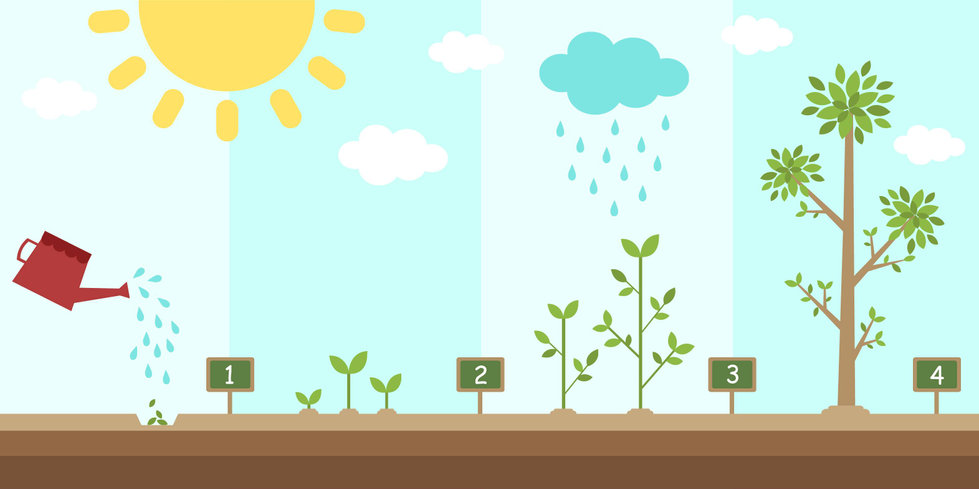
I’ll talk more about calories shortly, but suffice to say that you cannot see your body flourish and grow strong if you are constantly restricting your nutrient intake and not paying attention to the quality of the nutrients you eat. Poor quality soil impacts the growth of a plant, just like lack of quality nutrients will impact the efficacy of your workout. A plant grows in the presence of all of these nurturing variables in balance, and it takes a little time.
Your results will never happen without the combination of these actions (Sleep, Nutrition, Stress Management, Exercise) repeated, and you being patient and allowing the results to unfold.
Plants grow faster when they’re given all these resources, and your body will respond when you give it what it needs to thrive as well. That’s why we have what I refer to as the “4 Pillars of Health,” these 4 aspects of your life that only you can control and that work together to create that optimal state in your body.

With more of a focus on eating, sleeping, stress reduction and training to support your energy and valuable muscle tissue, you’ll have an easier time regulating your body composition at every stage of life, and you’ll feel stronger and healthier in the process. You will be less susceptible to advertising for “weight loss products” that prey on culturally created fears of women being undesirable (what a load of garbage).
Having a focus on growing and preserving our muscle, especially as we age is a great idea. Not only does muscle surround and protect our joints and organs, it secretes protective cytokines which boost your immune response during contraction (9) (10).
On the aesthetic front (how we look), muscle is dense and compact so as you add it to your frame you will become physically smaller and have a more toned appearance as discussed above. We burn more fat more easily when we’re more muscular (11), and that valuable muscle tissue has other protective benefits to our bodies as well. You’ll be physically stronger, enjoy a more robust immune response (9), and boost your sense of capability and confidence.
Focusing on muscle, and training strategies to grow it will not necessarily “bulk you up.” Getting muscularly large for women is achieved through years of intentionally working towards that goal, with targeted training and a lot of fuel. “Bulky” may mean different things to different people, but I feel that the fitness industry has created a fear of things like eating enough protein and focusing on muscle tissue with its male marketing focus on protein supplements and lack of understanding in the difference in the sexes.
You can add muscle to your body and focus on fueling for it without concern that you will become a bodybuilder. Professional female body builders work very hard to build up their muscle tissue to the level you see in competitions, and gaining muscle at that level is challenging due to the differences in amount of testosterone in men and women. If getting huge biceps is not an aesthetic goal for you, have no fear that you’re going to suddenly achieve it. But it is attainable for you if you choose to pursue it – I recommend a personal trainer who specializes in body building if this is of interest, and a willingness to spend years in pursuit of that goal.
V. Building muscle at different stages of your menstrual cycle
How do we build muscle? In a previous article, I described the process by which we gain muscle. In a nutshell, muscles working against a progressively challenging load leads to increases in muscle mass – a process referred to as hypertrophy. Hypertrophy is a thickening of the muscle fibers, creating stronger muscles.
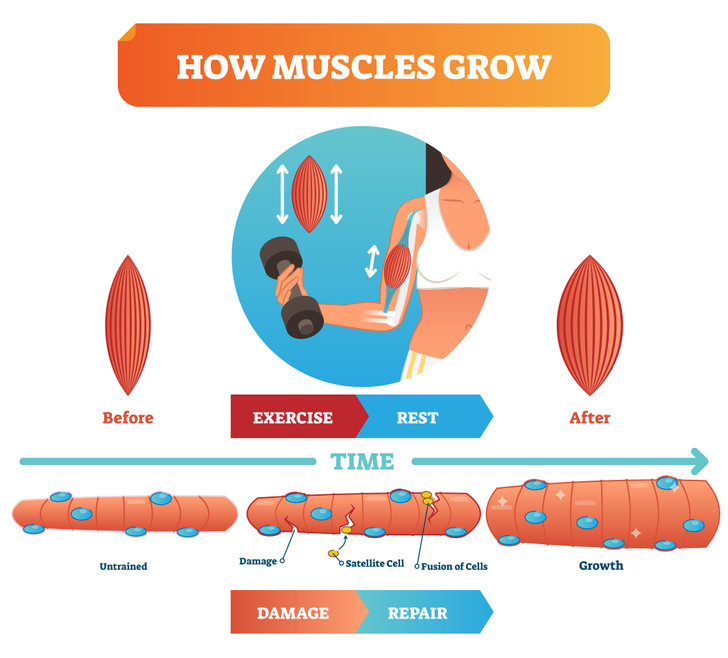
These adaptation to an increased load happens when we also fuel and rest properly. As the body gets used to the challenges you present it with, you need to vary the type of load in order to continue to drive adaptations. And for women, there are considerations due to the presence (or absence) of estrogen.
When you’re still having a regular cycle, remember that in the first half of your cycle (from when you get your period until you ovulate) estrogen is higher. This estrogen is estradiol, or E2 and it’s the most anabolic (muscle building) of the estrogen hormone trio (E1, E2, E3). During this phase, you also have a greater ability to use carbohydrates than you do post ovulation (be mindful of your consumption of sugary foods after you ovulate, and prioritize protein)(12 )(13)(14 ).
So if you’re still cycling regularly, take advantage of this first stage of your cycle (follicular phase) by pushing harder in your workouts (14) to create those muscular adaptations that lead to lean mass development.
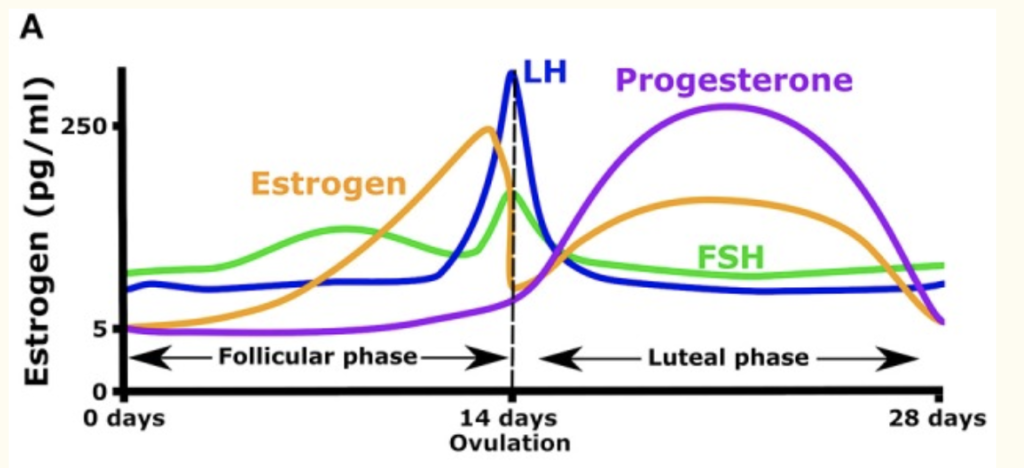
Balanced training is essential in the follicular phase as overtraining will contribute to more inflammation, elevated cortisol, and muscle protein breakdown. Not fueling and managing stress appropriately around your tough workouts will also have this effect and undermine your ability to build muscle.
After you ovulate (luteal phase), progesterone is going to be elevated, which will create a higher state of inflammation in your body as it prepares the uterine lining. Your basal body temperature is elevated, which may mean you get less deep sleep. Don’t push yourself as hard in this phase of your cycle – notice your energy needs and feel free to take the intensity down a notch or two.
You can really back off on the intensity of your training in the days or week leading up to your period, as you may notice less energy due to hormone levels shifting. I tend to do lower impact workouts during the days before my period as I just feel more tired. I’ll swap in yoga, mobility or just slower, less intense resistance training. Or simply take an extra rest day or 3 as needed.
How I adjust a program to match up with my cycle is if I’m following a 4-week training program for instance, I simply extend it a bit longer so I can add some days of lower intensity work in the week where I have less drive. I do some low impact workouts, yoga, mobility and even take just extra or unscheduled rest days the week before my period. Then I pick my training program back up where I left off when my estrogen levels come back up in the follicular phase.
See my detailed guide to training with your cycle for more on this subject and adjust your own workout plans with confidence. Looking for training guidance while pregnant, or after having a baby? Check out my pre natal and post partum fitness guides.
Some of the best training strategies for women at every life stage are resistance training (16) and HIIT (high intensity interval training that includes explosive cardio, or plyometric exercises)(15)(48) (49).
When it comes to resistance training, you want to begin by building a strong, functional base with good form and continue to progress and challenge yourself as your body adapts and you build strength (50).
Lifts like deadlifts, squats, pulls and pushes (among others) will all help increase your overall strength and when they’re incorporated into a balanced training plan that you are consistent with you will reap the rewards.
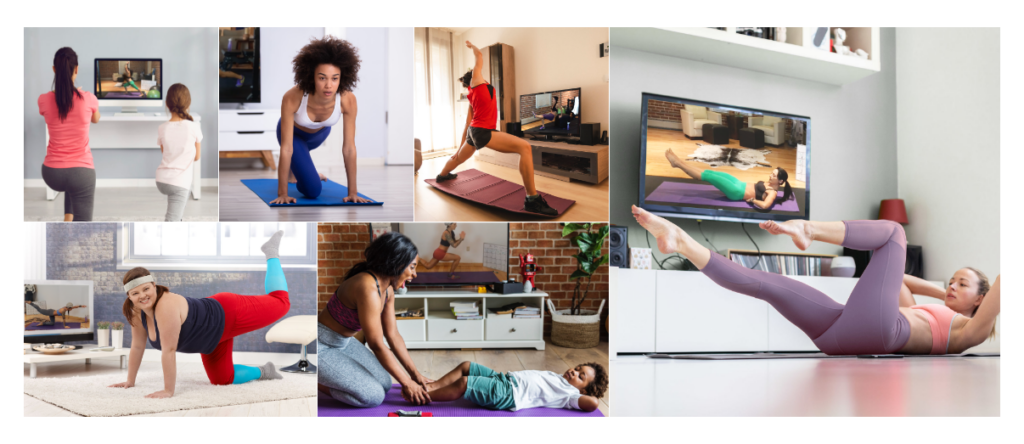
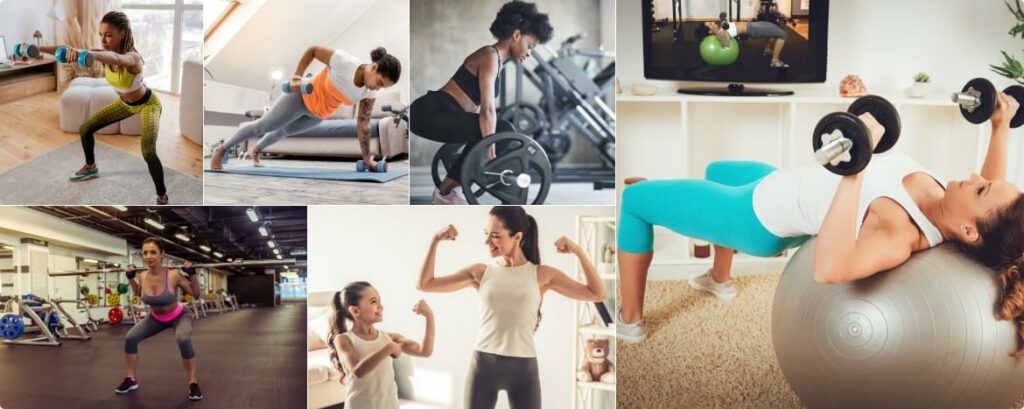
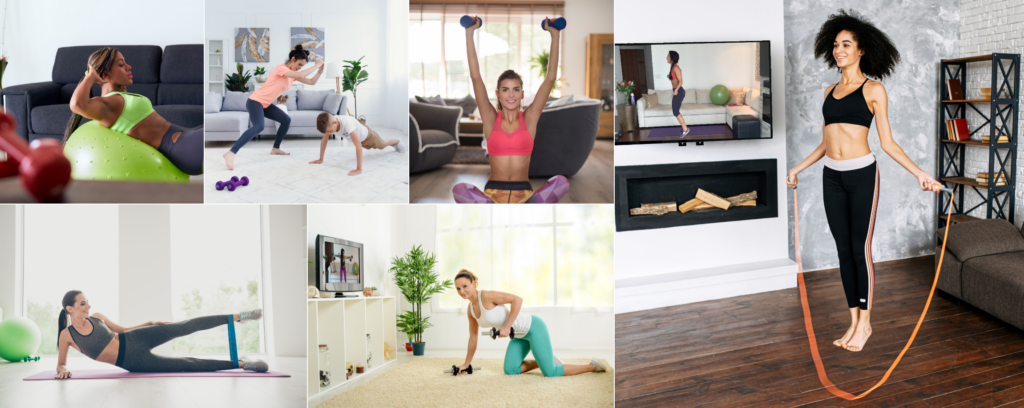
When it comes to HIIT/plyo/explosive cardio moves you want to be able to push hard in your work intervals (53). These intense intervals of explosive movement burn a lot of energy while you’re doing them, and trigger protein synthesis. They also increase growth hormone and adrenaline hormones which contribute to fat burning. HIIT workouts can also make you use more energy after your workouts as well.
Both resistance training and plyometric/explosive cardio moves are metabolically stressful, so your body burns more calories in the post workout recovery period (51). You’ll also trigger the release of hormones that have a fat-burning, appetite dampening response (54). You can find this combination of training strategies in every workout program I have created.
Workout plans that use these strategies
Click to expand and see descriptions
If you’re looking for a great bodyweight workout program that uses no equipment and will help you build a strong base of both resistance and explosive cardio, check out the 90 Day Challenge.
Your body will adapt to your training (50), so if you’ve built a strong base with bodyweight training, adding some additional resistance in the mix (like dumbbells or stretchy bands) can help you start to see more gains in muscle strength.
If you’ve been training with light dumbbells and know you could go heavier, start ramping up the resistance to your body by challenging yourself to increase the amount of weight of your dumbbells.
Check out Home Workout Domination for the perfect program that uses home workout equipment for resistance training and explosive cardio moves and will help you progress your strength.
I built up my collection of home workout equipment over time so don’t feel like you need to go purchase a ton of things. And if you’re working out in the gym, you can test out what works best by using the different options available.
If you get to the point where the weighted objects you’re holding are too heavy to comfortably grip and hold onto but you feel you could lift something heavier, consider using barbells as they make it easier to distribute the weight across the bar without you having to hold dumbbells.
Lioness, my women’s heavier weight training program is perfect for helping you progress through all of this if you’re interested in trying heavier weight training out. This program also includes plyometrics/explosive cardio.
For the best bang for your buck, you can join Rock Your Life, my online home workout studio and women’s fitness community where ALL of these options for strength training and explosive cardio are built into dozens and dozens of challenge programs.
Everything from foundational bodyweight training to home workout equipment to heavier weight training is available in Rock Your Life – plus support in our private women’t fitness community so you can progress with guidance and a holistic focus on your health.
Along with all of these training benefits we get from these strategies, understanding that “more is not more” when it comes to your training is an important aspect of your development as an athletic woman who is able to build muscle efficiently and burn fat.
As we discussed earlier, muscle grows when we rest it after we train (concurrent with proper fuel). You want to be able to go hard in your training sessions whether you’re resistance training or doing HIIT, and in order to push that limit you need to be rested and recovered.
Progressing with good form is of paramount importance, which is why I recommend following a program with a trainer who is well-versed in anatomy and functional movement (I’ll nominate myself here of course).
You can take advantage of my free foundations of functional fitness workshop alongside any of my training program or on its own to improve key movement patterns and understand more about how your body works and how to keep it balanced and aligned.
VI. Building muscle and losing fat for women in peri and post menopause
Post menopause you lose the E2 estrogen and the female sex hormones eventually flatline, so in order to build or maintain muscle we have to rely on other pathways to stimulate muscle protein synthesis.
In peri menopause we experience years leading up to menopause when our hormones and period become irregular. There is evidence that women of different cultural backgrounds experience differences in the length of this time period (52).
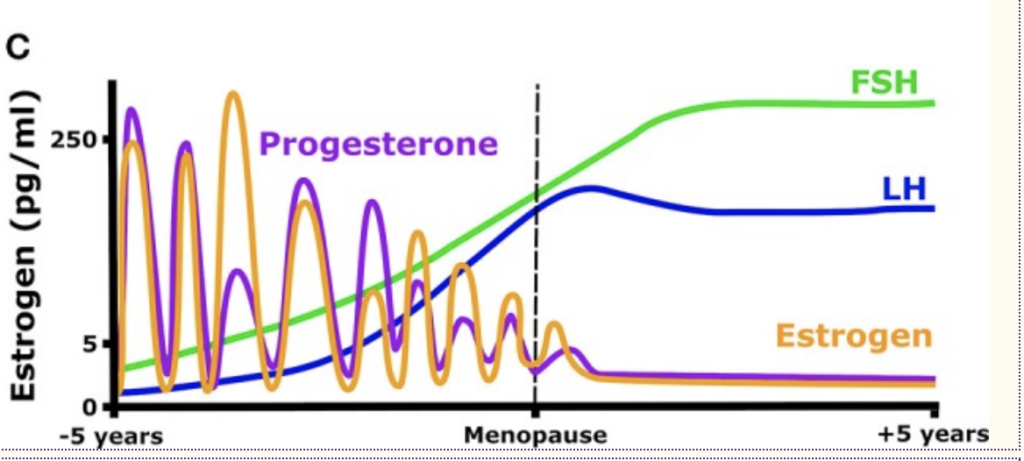
While estrogen is beneficial for body composition when we have a normal cycle (42), estrogen dominance creates issues for our ability to lose body fat and build muscle.
Check out the article about adaptogens which can help stabilize hormone levels (I have had an excellent experience using them myself), but other strategies may be recommended by your doctor (as long as they’re not dismissing your concerns, telling you to “go lose weight” or just putting you on the pill because they can’t be bothered to find alternative means to support you).
Watch out for chemical estrogens in plastics or industrial compounds. Poor estrogen metabolism can also contribute to estrogen dominance. We may not metabolize our estrogens when we have a poor diet, aren’t exercising regularly or lack muscle tissue. A balanced, whole food diet rich in fiber, healthy fats and essential amino acids from protein combined with regular exercise will contribute to better estrogen metabolism.
Here are the top tips for women in this life stage to shift body composition to less fat and more muscle:
1: Increase the challenge to your muscles from resistance training
Click to expand and read more
1: Increase the challenge to your muscles from resistance
One of the strategies for bypassing the hormone pathways is to increase the level of intensity of the workouts you do by increasing the resistance or weight you’re using. It’s time to start increasing the challenge to your muscles.



If you’re a beginner, work on challenging yourself by building up a foundational practice with bodyweight workouts (mine are some of the best!). Check out the 90 Day Challenge for a wonderful program that will progressively build up your strength with bodyweight workouts that can be done from home.
If you’ve been doing bodyweight workouts for a while and feel like you’ve got good form, it’s time to start adding in resistance in the form of bands, dumbbells or other weighted objects and challenge yourself further. Check out Home Workout Domination for the perfect program that uses home workout equipment for resistance training and explosive cardio moves.
If you’ve been training with light dumbbells and know you could go heavier, start ramping up the resistance to your body by challenging yourself to increase the amount of weight of your dumbbells.
I built up my collection of home workout equipment over time so don’t feel like you need to go purchase a ton of things. And if you’re working out in the gym, you can test out what works best by using the different options available.
Work with me in the circuits and workouts I teach, challenging yourself in the rep ranges I share, and increase the amount of resistance/weight you’re using gradually. If you get to the point where the weighted objects you’re holding are too heavy to comfortably grip and hold onto but you feel you could lift something heavier, consider using barbells as they make it easier to distribute the weight across the bar without you having to hold dumbbells.
Lioness, my women’s heavier weight training program is perfect for helping you progress through all of this if you’re interested in trying heavier weight training out.
For amazing value and variety, you can join Rock Your Life, my online home workout studio and women’s fitness community where ALL of these options for strength training and explosive cardio are built into dozens and dozens of challenge programs.
Everything from foundational bodyweight training to home workout equipment to heavier weight training is available in Rock Your Life – plus support in our private women’t fitness community so you can progress with guidance and a holistic focus on your health.
Include plyometrics/HIIT in your training
Click to expand and read more
2: Include plyometrics/HIIT in your training
The second strategy for bypassing the hormone pathways at this life stage is to make sure you’re including plyometrics (high intensity or explosive training moves like sprints, box jumps, broad jumps, skater lunges, tuck jumps, split squat jumps, burpees, jump squats, etc) in your workouts.
Not only is this great for your bone density, but when you fuel appropriately around your workouts the intensity of these moves uptakes glucose more quickly helping to keep insulin levels stable (which can be a challenge for women in peri or post menopause).
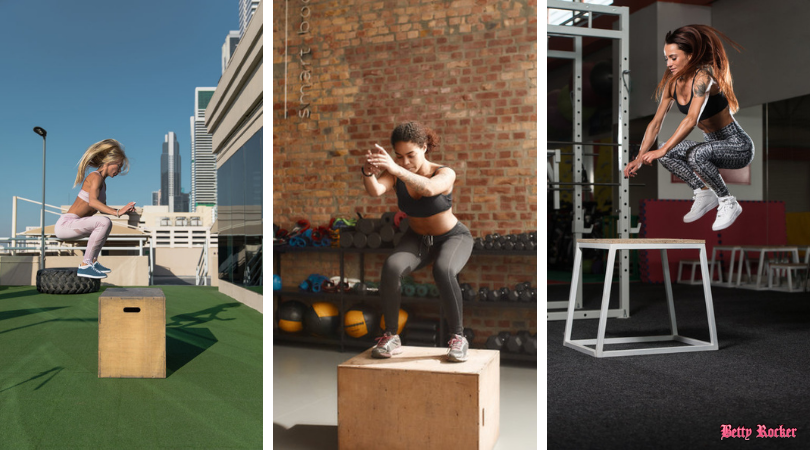
You’ll find explosive cardio included in all of my training plans allowing you to take advantage of this. You can begin with the lower impact versions that I’ll show you so you can get comfortable building yourself up.
Polarize your training and rest days
Click to expand and read more
3: Polarize your training and rest days
It’s also essential to start to look at the sequencing of your training. It’s no longer appropriate (nor was it ever really) to take a “no days off” approach to your training. You want to think about what Dr. Stacy Sims calls “polarizing” your training. Think about how you can set yourself up to make your training sessions maximally effective by coming to them rested, recovered and fueled.
Adjust workout programs that have 5 days of work in a row to be 2 days of work, followed by a rest day, 2 more days of work followed by a rest day, a day of yoga and then 2 days on again. Or do a workout every other day Monday through Friday, with a yoga day on the weekend and one additional recovery day.
Don’t get yourself into the “grey zone” where you’re training a little daily, thinking that’s going to be the way to lose the body fat – it’s not. Keeping your body in a constant state of inflammation is not what drives adaptations and muscle growth – it’s what breaks it down constantly and keeps your body from burning fat. Get your body moving doing low impact activities like walking regularly, and avoid long periods of sitting or inactivity. A rest day doesn’t mean you lie on the couch, but it also doesn’t mean you sneak in an extra workout.
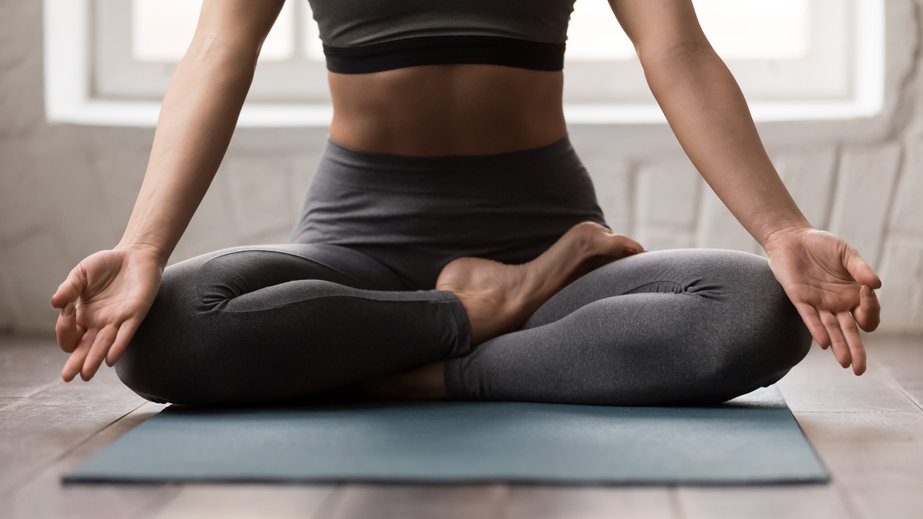
Increase your protein intake
Click to expand and read more
4: Increase your protein intake
In every life stage you want to nail your nutrient timing and recovery window to support your training, but in the later life stage you want to increase your protein intake even more as you lose the perturbation of estrogen cycling.
If you want to see your body composition shift toward more muscle and less body fat, you must prioritize your whole food intake and minimize sugary foods and processed carbohydrates. Stick to the whole food carbohydrates (you need them), healthy fats, and increase your protein intake from 20-30 grams per meal to more in the 30-40 grams per meal range.
If that seems extreme, start by simply looking at the amount of protein in each of your meals. You may want to look it up online if it’s a whole food and see how many grams are in the servings of foods you’re eating. Once you get familiar with this, start gradually increasing the amount.
There is a good reason to increase your protein intake. As we age, we don’t absorb the amino acids from our dietary protein as readily, so in order to stimulate the muscle we must increase our intake (36))(37). Ensure you are eating protein with each main meal, and that you’re getting complete protein (contains all the essential aminos your body can’t make on it’s own) with an optimal amount leucine, the most anabolic of the essential amino acids.
As a woman in her mid-40’s, this is one of the reasons I use Rock and Restore, my essential amino acid formula complete with BCAA’s and an optimal dose of leucine during my workouts.
Without this nutritional piece of the puzzle, your body will continue to break muscle down – which is why we see so many women losing muscle “tone” and gaining body fat as they go through this transitional time. Bombarded with fad diets claiming to be the “fix,” they’re eating less, overtraining, and their bodies are in a constant state of stress and inflammation leading to a down-regulated metabolism, thyroid issues, a lowered energy state, and the opposite results they were hoping for.
VII. For women of all ages: why we need to eat balanced meals with whole foods
The nutrients in your foods: protein, carbohydrates and fat, as well as the micronutrients like vitamins and minerals should all be part of the makeup of your meals. Getting familiar with these nutrients and what you’re putting in your meals is a great practice.
If you’ve ever used one of my meal plans you learn exactly which nutrients are featured in each meal, and get used to building a plate that supports your energy needs.
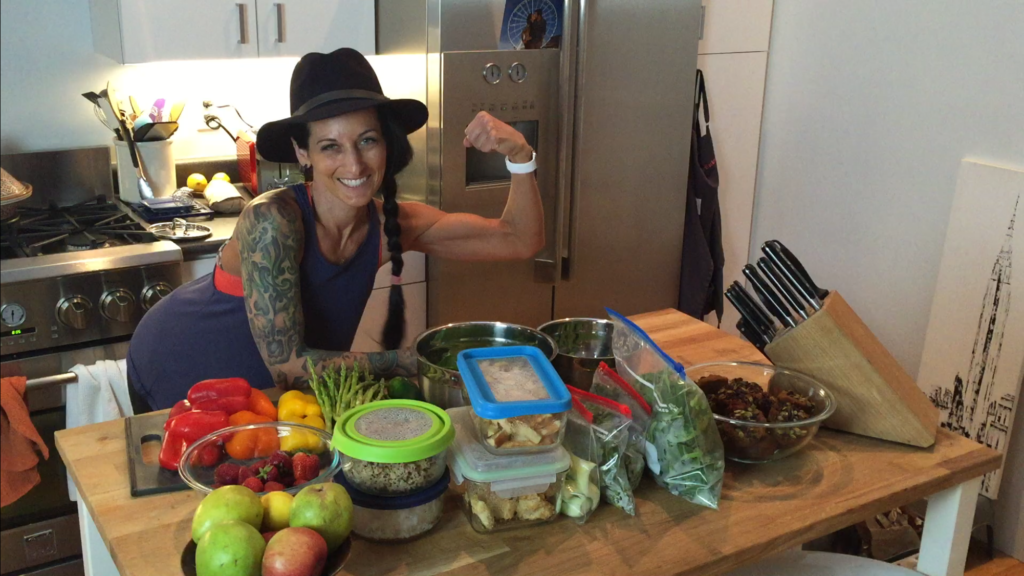
Doing food preparation is an excellent way to ensure you have the nutrients your body needs, and avoid added sugars that are in so many processed foods. This is why my message has not changed in a decade: cooking for yourself may not be “easy” and it may take some time, but it’s the quality of the soil you’re planting the seeds of your workout in.
I constantly see people putting all their focus and time into workouts and ignoring this essential piece of what drives their results. They jump from diet to diet looking for shortcuts when there are none.
You cannot force a plant to grow faster. It has to go through internal processes. So does your body. Expecting to see your results on the outside immediately is a losing game that food deprivation diet plans will have you believe.
So many online calculators for calories will put you at a dangerously low food intake threshold that actually has the opposite response in your body than you thought it would. It can have the unintended consequence of making you more prone to store fat, and you won’t build muscle on too little fuel.
The “salad” as a healthy meal without any protein or carbs is a great example of something we have come to perceive as a “health food” due to an over focus on calories, when it’s doing little to support our nutritional needs. Where is the protein? Where are the energy-providing, fiber-rich, gut supportive carbs? Where is the healthy fat?
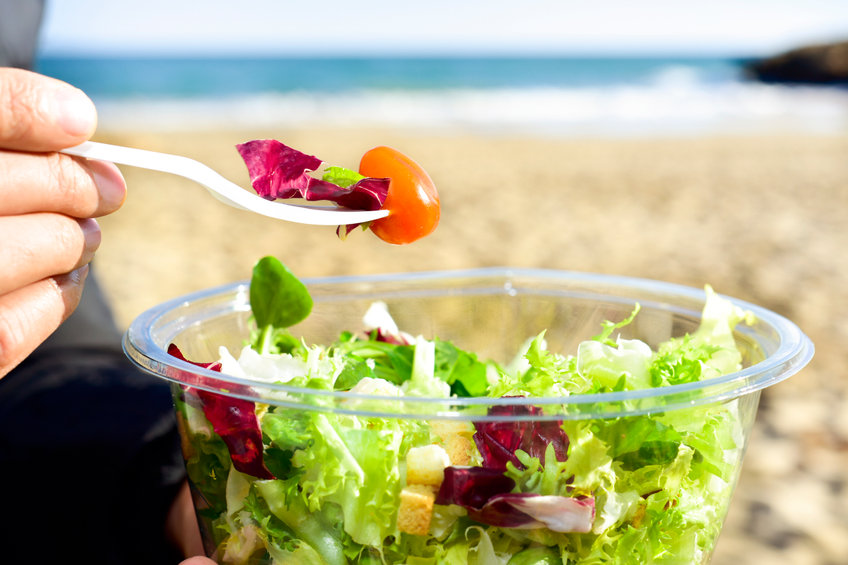
Each of us has a resting metabolic rate (RMR) which is the amount of fuel we need for just our basic functions. As in what it takes to digest your food, lay in bed and not do much more than be a body. For instance a woman’s RMR might be approximately 1400 calories (I’m 5’1″ and active and this is close to what mine is for instance). If she were to start eating 1200 calories a day (and training) she would quickly be in trouble, have low energy, be unable to lose body fat and likely lose muscle as well.
Due to the lack of essential nutrients – below even her baseline threshold, her metabolic rate slow down, making her body hold onto body fat, and this is what happens to so many women who eat too little because an online calculator or diet program told them “1200 calories.”
Focusing on eating foods for the calorie content rather than the nutrient content can rob you of vital energy and fuel for your activities, cognitive function, immune health and more.
This “low calorie” or “less food” type of approach plays into our damaging culturally taught association as women with “eat less to be smaller.” Why should women need to disappear or be smaller? These outdated messages about women’s bodies do not empower women, do not make us stronger or healthier – they make us more stressed, more prone to illness and injury, and physically weaker.
Why protein is so important
Click to expand and read more
Why protein is so important
Protein is the most satisfying of the nutrients, so it can help with portion control and meal satisfaction when you have it in adequate amounts in each of your main meals (38).
Protein will help stabilize your blood sugar, and it breaks down into the amino acids that your body needs for everything from muscle protein synthesis (39) to brain function, hormone and enzyme function and immune health.
You cannot build or maintain muscle without adequate protein intake, and it has the added benefit of keeping you feeling full and satisfied when you include it in your meals.
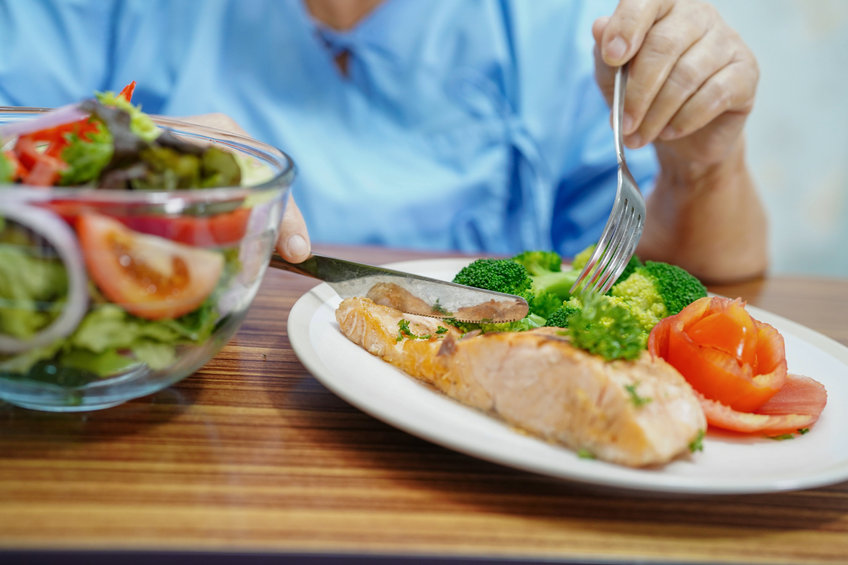
I see too many women eating barely enough protein and then they wonder why they have sugar cravings, why they’re hungry all day, or why they can’t get “toned,” which means why can’t they see more muscularity and less body fat.
Include protein with each main meal (40), because your body doesn’t have a “storage reserve” to draw from for the aminos it needs for so many body functions (including cognitive function, immune function, hormone and enzyme function and muscle protein synthesis). When you go too long without eating, your body will break down your muscle tissue to get at the amino acids that are there, which isn’t what you want.
It’s great to learn about the macronutrients, and if you want to “count” any of them I would say start tracking how many grams of protein are in each of your meals so you get a general idea of how much you’re eating per meal. Aim for 20-30 grams per meal, and if you’re over 40, aim for 30-40 grams per meal as discussed above in the peri and post menopause section.
You can easily boost your overall daily intake with quality protein powders to help meet the body’s needs for amino acids (13). I personally like adding them to my smoothies, to my oatmeal, baking them into muffins, pancakes and waffles, and even mixing them into yogurt to eat with my breakfast cereal (click here for protein rich recipes on the blog). In the picture of me above with the food prep, there are protein muffins in the glass bowl for instance, and I’ve washed my greens and bagged them as a quick addition to smoothies.
If you don’t tolerate dairy well and don’t use whey protein powder, plant based protein powders like my organic whole food proteins are an excellent choice as they contain all of the essential aminos, and I made them to be tasty and smooth enough to be mixed in just water alone if you’re busy, on the go, or want something very light.
Collagen is also an excellent supplement to support the integrity of bone, skin and joint health as it contains some specific amino acids. It is not a complete protein source however, so it is best used in conjunction with a complete protein source powder. I personally always add it (here’s the one I make) to my Rock and Restore since it dissolves in anything and has no flavor or taste.
To read about how to use different supplements like collagen, protein powder and aminos, read this post.
Don’t avoid whole food carbs
Click to expand and read more
Don’t avoid whole food carbs
The biggest issue when it comes to carb consumption is eating too many processed foods and not getting enough vegetables, fruits, whole grains and legumes. You may have dietary preferences for specific whole food carbohydrates and that’s fine – but eat the ones that you prefer from whole food sources full of fiber, and not the processed ones.
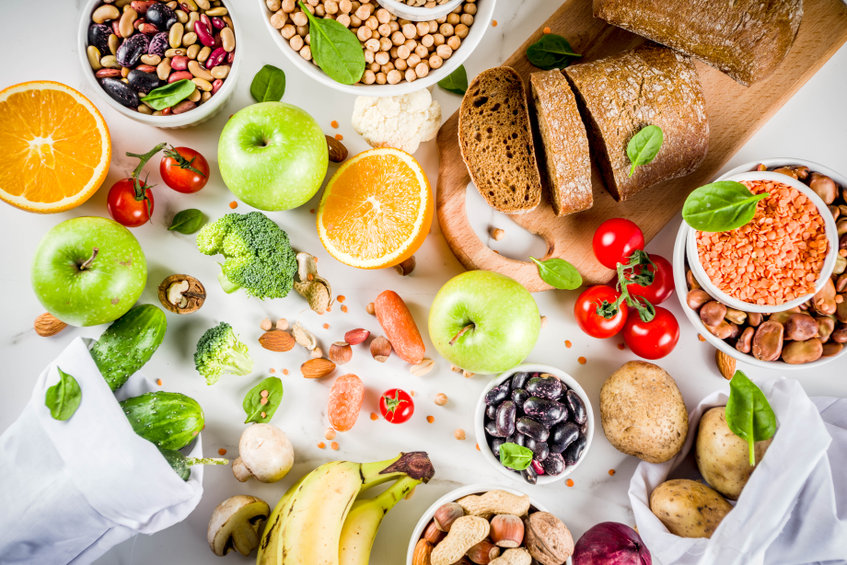
When you eat carbohydrates, your insulin rises to uptake the glucose in your bloodstream from the carbohydrates. Whole food carbs cause a gradual elevation of blood sugar levels, making it easier for your body to manage the glucose (which is ideal). But many processed foods release a lot of sugar into the bloodstream very quickly.
When you have too much glucose in your blood, your body stores it as fat. When you eat too much sugar too often your cells become resistant to the insulin that’s trying to unlock them to let glucose in, which is a precursor to diabetes and obesity.
This is not to say you should never enjoy processed foods, treats, dessert or sweets. But making them your staples rather than your “specials” is an approach that leads to health concerns. Your gut health will be greatly improved with a focus on more fiber rich whole food carbohydrates and your blood sugar will be more stable, delivering steady energy rather than energy spikes.
If you’re going to opt for a lower carbohydrate meal, do it away from your workouts. Remember that the post workout window (the time after a workout) is the time when your body is most sensitive to insulin and can send the sugar in your bloodstream straight to replenishing your muscle glycogen stores.
The more muscle you have, the better your metabolic health is and the easier it is to lose body fat (41). Eating carbohydrates and protein together around your workouts supports your energy balance and your ability to build and maintain your muscle tissue (38).
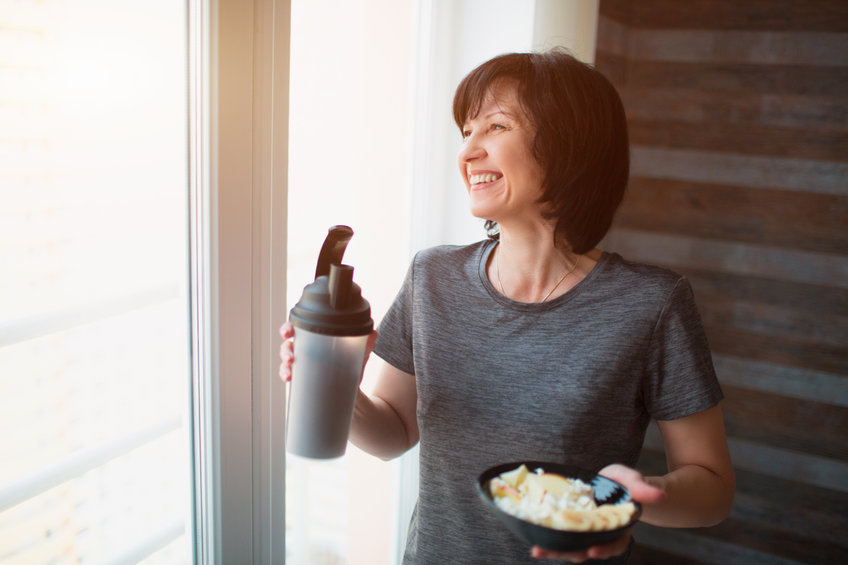
Due to our higher levels of estrogen than men, we also have an improved ability to burn carbohydrates especially in the first half of our cycle when estrogen is higher (42)(43). You can go higher in your carb intake in this phase after your workouts, especially on tough training days.
If you’re in the second half of your cycle (from ovulation to your period), you have more progesterone in your system. Progesterone increases muscle breakdown (31), so you really want to make sure you’re optimizing your protein and carbohydrate intake in the luteal phase, and having your recovery time as well (32). For a refresher on the phases of your cycle, read my cycle training guide).
These nutrition strategies are essential for women in peri and post menopause as well, as discussed earlier. As we lose our naturally fluctuating estrogen, it’s imperative to prioritize whole food carbohydrate sources and increase our protein intake. We don’t absorb as much of the amino acids from our protein as we age, meaning increasing it serves multiple purposes at this time that help you improve body composition, lose body fat, and preserve or gain muscle.
Enjoy quality dietary fat
Click to expand and read more
Enjoy quality dietary fat
From a satisfaction and fullness standpoint I also don’t recommend being afraid of dietary fat. When women limit fat, they tend to eat more carbs which increases insulin and decreases our ability to burn fat. We can also disrupt our hormones as the body uses the cholesterol in dietary fat to produce them.
Key nutrients in fish, eggs, nuts and other sources of dietary fat are readily absorbable and utilized by the body. Our hunger may be elevated without the satiating effect of dietary fat, causing us to overeat more frequently, and studies have investigated the higher incidence of injuries in athletic women who ate a lower fat diet (44).
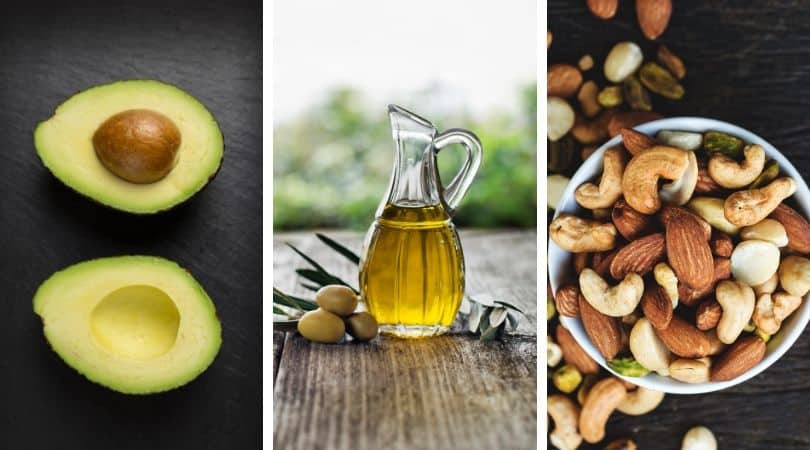
So don’t be afraid to include whole food sources of fat in your meals in balance with your other nutrients. Avoid processed fats like vegetable oil and hydrogenated or trans fats. If you’re struggling to create balanced meals, get a meal plan like the Body Fuel System with balanced whole food meals.
VIII. The importance of fueling (not fasting) around your workouts and how to do it
Many women are still doing fasted training, thinking that’s giving them the edge. However studies (17) show that women do better when training in a fed state, while men do well in a fasted state (18).
The reason you’re hearing so many diets and doctors advertising fasting as the way to go is because the previous research suggested many benefits. And there are benefits, to the subjects who were studied: men.
The female physiology is more sensitive to hunger and fullness signals due to us having more kisspeptin receptors in our brain than men do(19). Staying in an under fueled state contributes to a slowed metabolism, meaning your body can’t burn calories as readily and is conducive to a low energy state.
One of the purported benefits of fasting that it forces the body to switch from glucose burning to fat burning. However there are sex differences that provide this mechanism in women already. Women burn more glucose during regular daily activities, but burn more fat during exercise naturally than men do (20)(13).
Exercise helps women call on our body’s ability to burn fat for fuel, making us more metabolically flexible when we incorporate regular training, supported with the fuel we need. Not to mention, exercise induces autophagy (21), one of the other oft-touted benefits of fasting in which the body clears out damaged cells. In a nutshell, exercise gives women similar benefits as men get from fasting.

There are of course many ways to fast and many reasons. I appreciate and respect that some of my readers may have religious reasons for observing periods of fasting. The scope of this section of our article is focused on fasting as it pertains to women in sport.
We all naturally “fast” in a lower energy output state when we stop eating after dinner and don’t eat again until breakfast. But skipping breakfast or going long periods without fuel can be unhelpful for active women by elevating our cortisol (which contributes to muscle breakdown and fat storage) and creating an energy deficit that means you won’t be able to work as hard in your training session.
Not to mention, coming into your workout after a long fast means your body is in a muscle breakdown state. When your body doesn’t receive the essential amino acids it needs for everything from brain function, hormone and enzyme function, immune function AND muscle protein synthesis, it breaks down your muscle tissue to get the amino acids in this valuable body tissue (22).
During your workout, muscle protein synthesis and muscle protein breakdown occur, but the exercise creates a greater breakdown state potentially leaving you in a deficit unless you are fueled, and/or fuel to replenish the work. The breakdown of your muscle tissue during a workout has the potential to create hypertrophy and muscle growth after your training session as your body repairs when you fuel and rest properly (23).

So if you went into your workout fasted (in a muscle breakdown state plus elevated cortisol which means fat storage state), then did your workout and then didn’t eat for an hour or so post workout (muscle breakdown state plus fat storage from the stress of the workout and lack of nourishment) you just broke down your muscle tissue the entire time without build back because your brain and body were looking for amino acids to use for essential body function and stored glycogen for energy. It got both of those from your valuable muscle tissue (34).
So all of this “skipping meals” means you aren’t building muscle, you’re breaking it down. Remember that cortisol (the stress hormone) is catabolic (breaks down) muscle, and anabolic (builds up) to fat. This stressful state does not contribute to fat loss, it can actually lead to fat gain. And the lack of nutrients contributes to loss of your precious muscle tissue.
All those claims about fasted training making you “lose weight” might have made you lose a few pounds but where did the pounds come from? Sure you may have lost some body fat, but you also lost your vital muscle tissue and elevated your cortisol. A man will have a different response and be able to lose fat and preserve muscle tissue. Extensive fasting as a woman, especially around your workouts all but guarantees you’re going to gain body fat over time, lose muscle, and also affect your body’s metabolic rate (35). Understanding body composition and how your muscle actually gets stronger is so important.
I don’t recommend fasted training for women. Having fuel around your workouts (in the form of protein and carbohydrates) is essential so you not only have the energy to push hard and get those adaptations in the muscle tissue, it fuels the cells with glycogen (the byproduct of glucose from carbohydrates) and the amino acids (the byproducts from dietary protein or protein powder) support muscle protein synthesis.
Fueling post-workout
In the post workout window after you exercise, your insulin levels peak which creates the opportunity for glycogen storage (glycogen comes from the glucose in carbohydrates) and muscle repair. That means the carbs you eat post workout can get straight to the muscle stores, and the amino acids from the protein you eat can get to the muscle tissue to repair the breakdown created by your training. Once we are outside of this window, our insulin sensitivity goes down, making it harder for the muscles to absorb the glucose from your bloodstream and the amount of glycogen stored in your muscles is lower.
Post workout, women have a relatively short window for optimal refueling compared to men who may be able to go longer (24). Ideally, get protein and carbohydrates in within an hour of training (13) in your next meal. Aim for 25-30 grams of protein in the recovery period (33).
The carbs will increase your glycogen storage, and combining protein and carbs can help reduce inflammation and support a strong immune system. Muscle uptakes glucose from the bloodstream as well, so the more muscle you carry the better you handle the insulin response.
This is one of many reasons I suggest pre-cooking some of your meals for the week ahead, so you have easy to grab and go meals when you need them. See my meal plans for easy to follow guides.

The body will store the energy from the carbs we eat in the liver and the muscle tissue, and use what it needs for energy first from the liver, but it will break down your muscle tissue if you’re not eating enough for your energy output needs (26). If we eat more carbohydrates than the body has the capacity to store in the liver and muscle tissue it gets stored as fat. So you’ve got too little and too much – both with consequences.
If you eat well balanced meals with protein (very satisfying), whole food, fiber-rich complex carbohydrates (digest slowly, keeping blood sugar stable) and healthy dietary fat (slows gastric emptying to keep blood sugar stable and also is very satisfying) you are in very little danger of under eating or overeating, and can stop worrying about “carbohydrates making you fat.”
Using an eating program like the Body Fuel System can set you up with an easy to follow guideline and delicious well-balanced meals.
Carbs are the body and brain’s preferred energy source. Yes, the low carb/high fat diets out there will make you think the body needs to run on ketone bodies, and it can – however that is an adaptation the body has for starvation and low food availability states. Diets like these generally do not serve women very well, and the “benefits” of the keto diet in particular is all based on research on male test subjects (27).
They may work better for men, having been studied extensively on them, be useful for a short period of time for certain individuals, especially those who are obese or have other medical conditions. But going extremely low carbohydrate for active women long-term can have unwanted consequences to your cortisol levels (they rise) and your metabolism (it can down regulate).
Want to hear scientist and researcher Dr. Stacy Sims explain why intermittent fasting, keto, and low carb diets aren’t ideal for women, but work well for men? Listen to the podcast we did together about this topic right here.
You’ll want to prioritize protein and carbs around your workouts (28) – so if you can workout a couple hours after your last meal, and eat your next meal within an hour of your training session, you’re doing great. Just make sure your meals contain protein and carbohydrates (29).
Strategies for fueling pre and post workout with a busy schedule:
Ideally we’d all have the ultimate flexibility of eating whole food meals and training at the perfect times for ourselves, but with the demands of modern life, protein supplements can come in handy and help fill in some gaps. Let me run you through a few scenarios and ways you can use protein powders and smoothies (in addition to whole food meals of breakfast, lunch and dinner) to support you so that this isn’t confusing and it’s easy to implement.

- You work out first thing in the morning: have a half of a banana (or any other fruit) and a scoop of protein powder in water or almond milk. Something super light that digests quickly will ensure you have the building blocks you need circulating in your system for optimal output in your workout. Eat breakfast as soon as you can after your workout.
- You work out an hour or two after breakfast: if it’s not time for lunch yet, have a protein shake with fruit right after your workout. If it’s time for lunch, have lunch. If you have the shake and fruit, have lunch when it’s time for lunch, as the smoothie/shake isn’t a meal replacement.
- You work out on your lunch break, and haven’t eaten since breakfast (you plan to eat your lunch after your workout): an hour or so before you workout, have a blended smoothie with protein and the other things you put in a full smoothie (something you’d find in one of my recipe guides for instance that you can bring it from home or make at the office, not just protein powder in water). If you lack the means to make the smoothie, have the protein in water or milk and a piece of fruit sometime in the hour before you train to give yourself a base. Have your lunch as soon as you can after you train.
- You work out after work, and haven’t eaten since lunch (you plan to eat dinner after you train): an hour or so before you workout, have a smoothie with protein and the other things you put in a full smoothie that you blend (something you’d find in one of my recipe guides for instance that you can bring it from home or make at the office – not just protein in water). If you lack the means to make the smoothie, have the protein in water or milk and a piece of fruit sometime in the hour before you train to give yourself a base. Have your dinner as soon as you can after you train.
- You work out after dinner: Make sure you work out at least 3 hours away from bedtime, as training too close to bedtime can interfere with your sleep as it raises your core body temperature. I presume you ate dinner at least an hour before your workout, giving you time to digest. After dinner, make yourself a full smoothie (like something that you’d find in my recipe guides) with protein, milk, fruit and other ingredients, or a shake with just protein powder and water and a piece of fruit.
The protein/water and fruit is just a shortcut, a convenient way to support nutrient timing when you aren’t able to eat a regular meal or regular food on one side of your workout. You can use a protein shake as a support for nutrient timing – but I don’t suggest using them as a full meal replacement. Your body needs whole foods too(30).
I just want to mention that supplements are not required, they are a supplement to a healthy, whole food diet. I use them because they are a convenient way to get extra nutrients in quickly and conveniently. If they seem expensive compare the cost of complete protein in foods you would prepare. Quite often, they are very comparable. However, not finding the quality I wanted consistently in the marketplace is why I started my own supplement line.
While I use a regular protein powder in my smoothies and focus on whole food sources of protein in my meals, during my workouts, I use Rock and Restore, my essential amino acid formula. It’s in a “free form” which means it doesn’t have to be digested like dietary protein and can go straight to where it’s needed. An essential amino acid contains the BCAA’s (branch chain amino acids) but my formula has an optimal dose of leucine, the most anabolic of the BCAA’s, making it a great workout formula.
If you are unable to purchase my organic protein powders and supplements, here is my guide to choosing protein powders that can help you make good decisions about what ingredients are in the products you are shopping.
Of course protein powder and supplements are totally optional and I use them for convenience and because as we age, we absorb less of the amino acids from our food as I mentioned previously, and I want to create a nice circulating pool of them during my training which helps with post workout soreness and drives muscle protein synthesis.
IX. Why reduced stress levels and quality sleep are also essential for body composition shifts
I must also mention that stress is a huge factor in our ability to regulate our body composition. You’ve probably heard me say that exercise is a healthy stress when we are healthy. There are many forms of stress to the body, but chronic stress from emotional or life triggers are essential to address (read my complete article about stress here).
We can also create a state of stress in the body when we overtrain, or don’t take the needed recovery when we’re sick or injured and the body is trying to do too many tasks at once.
Whether from life stress or overtraining, stress elevates the cortisol in our body and we’ve discussed already that it stimulates fat storage (45) and breaks down muscle tissue. Developing methods to proactively address the stressors you face can be incredibly beneficial and supportive to your energy and fitness goals.

Doing “extreme” workouts, or not getting adequate recovery both during a workout or after may increase muscle breakdown, persistent inflammation, and lowered immune response (46).
Speaking of a lowered immune response, lack of sleep also makes us more susceptible to getting sick. Good sleep is an essential component to training and seeing results. When you’re exercising, you need MORE deep sleep for muscle recovery and protein synthesis. During sleep, your body produces HGH (human growth hormone) which boosts protein synthesis and promotes fat utilization.
Quality sleep is also crucial for maintaining the balance of the hormones that make you feel hungry (ghrelin) or full (leptin). When you don’t get enough sleep, your level of ghrelin goes up and your level of leptin goes down, resulting in an increase of appetite and cravings – and our impulse control goes down, making it very hard to avoid reaching for the sugar and pre made foods.

Our metabolism slows down and our body holds onto its resources (body fat) and doesn’t burn as many calories (47). Along with all this, lack of sleep causes our cortisol levels to rise and remain elevated. This high cortisol impacts fat loss efforts, and promotes breakdown of your muscle tissue.
Which is why when you are really tired, I recommend that you take an active recovery or rest day, even if it’s unscheduled. Training in this sleep deprived state will only contribute to greater muscle breakdown and won’t give you the benefits, plus you’ll be more likely to reach for comfort foods and have less inhibition in overeating.
You can listen to Dr. Michael Breus (The Sleep Doctor) go over the 5 things that happen to your metabolism and hormones when you’re sleep deprived on the podcast here.
X. To wrap it all up….
As a woman, you have training advantages and a unique, powerful body that is capable of going through numerous transitions in the course of its lifespan. I encourage you to see this process of figuring things out as a discovery, not a burden. There is no pressure on you to implement everything you learn immediately. Try these things out for yourself, and remember that like a plant, the body must also go through an internal process before you “see a result.”
Having additional resources can be very helpful. Personally, I have sought the support of numerous practitioners over the years including therapy for my mental health, functional medicine for my physical body and looking for the root cause of things that are hard to understand, physical therapy for support with stability and foundational movement patterns, and Chinese medicine for my energy body (acupuncture and herbal medicines) to name a few. I work with a functional medicine doctor (root cause medicine) rather than a traditional MD. You can use the directory here to search for functional medicine practitioners in your area if this is of interest.
While we may not all seek out the same types of practitioners or care, there are still plenty of things within our personal domain that only we can control like our 4 Pillars of Health: Sleep, Nutrition, Stress Management and Exercise. I hope that with this article you have seen a new level of how you can apply these 4 pillars in your own life to drive the results you want with all the effort you put in.
I invite you to be a part of ROCK YOUR LIFE, my online home workout studio and empowering women’s fitness community. You’ll find workout programs, workout classes of all types, healthy recipes and a holistic approach to your health in your private member’s login area, and in our private group enjoy lively discussions about all topics relating to your health and well being, a connection with other like-minded women, interaction with myself and the Team Betty Rocker Coaches.
When we focus more on designing a high quality of life for ourselves from a holistic perspective, the body responds naturally and becomes the fit, strong body we wanted all along. It’s so satisfying and empowering when we take action from an educated standpoint, and control the framework we see ourselves through as strong, powerful women with highly functional, healthy bodies that do not exist solely to be looked at. I look forward to your comments and questions.
For additional learning:
- Women specific nutrition and training with Dr. Stacy Sims
- Eating and training with your cycle (part 1) with Dr. Stacy Sims
- Eating and training with your cycle (part 2) with Dr. Stacy Sims
- A quickstart guide to women’s hormones (part 1)
- A quickstart guide to women’s hormones (part 2)
- What you need to know about birth control, the menstrual cycle and your hormones with Dr. Jolene Brighten
- How to heal emotional Eating with Tricia Nelson
- How to have a happy, healthy gut with Dr. Vincent Pedre
References:
-
-
- Brookshire, Bethany. “Women in sports are often underrepresented in science.” ScienceNews. May 2016. Web. https://www.sciencenews.org/blog/scicurious/women-sports-are-often-underrepresented-science
- Kong, Peiling and Harris, Lynne M. “The Sporting Body: Body Image and Eating Disorder Symptomatology Among Female Athletes from Leanness Focused and Nonleanness Focused Sports.” The Journal of Psychology. March 2014. Web. https://www.tandfonline.com/doi/abs/10.1080/00223980.2013.846291
- Jagim, Andrew R et al. “The Influence of Sport Nutrition Knowledge on Body Composition and Perceptions of Dietary Requirements in Collegiate Athletes.” Nutrients. June 2021. Web. https://pubmed.ncbi.nlm.nih.gov/34209814/
- “Body Composition.” UC Davis Health. Web. https://health.ucdavis.edu/sportsmedicine/resources/body-fat.html
- Yeager, Kimberly K. et al. “The female athlete triad disordered eating, amenorrhea, osteoporosis.” Medicine & Science in Sports & Exercise. July 1993. Web. https://journals.lww.com/acsm-msse/Citation/1993/07000/The_female_athlete_triad__disordered_eating,.3.aspx
- Melin, Anna K. et al. “Energy Availability in Athletics: Health, Performance, and Physique.” International Journal of Sports Nutrition and Exercise Metabolism. Feb 2019. Web. https://pubmed.ncbi.nlm.nih.gov/30632422/
- Jaime, Teresa Jiménez et al. “Effect of calorie restriction on energy expenditure in overweight and obese adult women.” Nutricion hospitalaria. June 2015. Web. https://pubmed.ncbi.nlm.nih.gov/26040348/
- McPherron, Alexandra C. et al. “Increasing muscle mass to improve metabolism.” Adipocyte. April 2013. Web. https://www.ncbi.nlm.nih.gov/pmc/articles/PMC3661116/
- Nielsen, Søren and Bente Klarlund
Pedersen. “Skeletal muscle as an immunogenic organ.” Current opinion in pharmacology. June 2008. Web. https://pubmed.ncbi.nlm.nih.gov/18417420/ - Iizuka, Kenji et al. “Skeletal Muscle Is an Endocrine Organ.” Journal of Pharmacological Science. 2014. Web. https://www.jstage.jst.go.jp/article/jphs/125/2/125_14R02CP/_article
- Vechetti Jr, Ivan J. et al. “Mechanical overload-induced muscle-derived extracellular vesicles promote adipose tissue lipolysis.” The FASEB Journal. May 2021. Web. https://faseb.onlinelibrary.wiley.com/doi/10.1096/fj.202100242R
- Oosthuyse, Tanja and Andrew N. Bosch. “The Effect of the Menstrual Cycle on Exercise Metabolism.” Sports Medicine. Oct 2012. Web. https://link.springer.com/article/10.2165/11317090-000000000-00000
- Wohlgemuth, Kealey J. et al. “Sex differences and considerations for female specific nutritional strategies: a narrative review.” Journal of the International Society of Sports Nutrition. April 2021. Web. https://www.ncbi.nlm.nih.gov/pmc/articles/PMC8015182/
- Devries, Michaela C. et al. “Menstrual cycle phase and sex influence muscle glycogen utilization and glucose turnover during moderate-intensity endurance exercise.” American Journal of Physiology. Oct 2006. Web. https://journals.physiology.org/doi/full/10.1152/ajpregu.00700.2005?rfr_dat=cr_pub++0pubmed&
- Trapp, E G et al. “The effects of high-intensity intermittent exercise training on fat loss and fasting insulin levels of young women.” International Journal of Obesity. Jan 2008. Web. https://pubmed.ncbi.nlm.nih.gov/18197184/
- Osterberg, K L and C L Melby. “Effect of acute resistance exercise on postexercise oxygen consumption and resting metabolic rate in young women.” International Journal of Sports Nutrition and Exercise Metabolism. March 2000. Web. https://pubmed.ncbi.nlm.nih.gov/10939877/
- Zouhal, Hassane et al. “Exercise Training and Fasting: Current Insights.” Open Access Journal of Sports Medicine. Jan 2020. Web. https://www.ncbi.nlm.nih.gov/pmc/articles/PMC6983467/
- Stannard, Stephen R. et al. “Adaptations to skeletal muscle with endurance exercise training in the acutely fed versus overnight-fasted state.” Journal of Science and Medicine in Sport. July 2010. Web. https://www.jsams.org/article/S1440-2440(10)00073-3/fulltext
- Navarro, Víctor M. “Metabolic regulation of kisspeptin — the link between energy balance and reproduction.” Nat Rev Endocrinol. Feb 2022. Web. https://www.ncbi.nlm.nih.gov/pmc/articles/PMC8852368/
- Blaak, E. “Gender differences in fat metabolism.” Current opinion in clinical nutrition and metabolic care. Nov 2001. Web. https://pubmed.ncbi.nlm.nih.gov/11706283/
- Vainshtein, Anna and David A. Hood. “The regulation of autophagy during exercise in skeletal muscle.” Journal of Applied Physiology. Dec 2015. Web. https://www.ncbi.nlm.nih.gov/pmc/articles/PMC4796178/
- Carbone, John W. and Stefan M. Pasiakos. “Dietary Protein and Muscle Mass: Translating Science to Application and Health Benefit.” Nutrients. May 2019. Web. https://www.ncbi.nlm.nih.gov/pmc/articles/PMC6566799/
- Moore, Daniel R. “Maximizing Post-exercise Anabolism: The Case for Relative Protein Intakes.” Frontiers in Nutrition. Sept 2019. Web. https://www.frontiersin.org/articles/10.3389/fnut.2019.00147/full
- Henderson, Gregory C. et al. “Glucoregulation is more precise in women than in men during postexercise recovery.” The American Journal of Clinical Nutrition. June 2008. Web. https://academic.oup.com/ajcn/article/87/6/1686/4633469?login=false
- X Holtzman, Bryan and Kathryn E. Ackerman. “Measurement, Determinants, and Implications of Energy Intake in Athletes.” Nutrients. March 2019. Web. https://www.ncbi.nlm.nih.gov/pmc/articles/PMC6472042/
- Burd, Nicholas A. et al. “Exercise training and protein metabolism: influences of contraction, protein intake, and sex-based differences.” Journal of Applied Physiology. May 2009. Web. https://journals.physiology.org/doi/full/10.1152/japplphysiol.91351.2008#
- Durkalec-Michalski, Krzysztof et al. “Effect of a four-week ketogenic diet on exercise metabolism in CrossFit-trained athletes.” Journal of the International Society of Sports Nutrition. April 2022. Web. https://www.tandfonline.com/doi/full/10.1186/s12970-019-0284-9
- Tarnopolsky, M A. “Gender differences in metabolism; nutrition and supplements.” Journal of Science and Medicine in Sport. Sep 2000. Web. https://pubmed.ncbi.nlm.nih.gov/11101268/
- Kumar, Vinod et al. “Human muscle protein synthesis and breakdown during and after exercise.” Journal of Applied Physiology. June 2009. Web. https://journals.physiology.org/doi/full/10.1152/japplphysiol.91481.2008
- Jeukendrup, Asker E. ”
Training the Gut for Athletes.” Sports Medicine. March 2017. Web. https://pubmed.ncbi.nlm.nih.gov/28332114/ - Lamont, L S et al. “Menstrual cycle and exercise effects on protein catabolism.” Medicine and Science in Sports and Exercise. April 1987. Web. https://pubmed.ncbi.nlm.nih.gov/3574042/
- Holtzman, Bryan and Kathryn E. Ackerman. “Recommendations and Nutritional Considerations for Female Athletes: Health and Performance.” Sports Medicine. Sep 2021. Web. https://www.ncbi.nlm.nih.gov/pmc/articles/PMC8566643/
- Pihoker, Alexis A et al. “The effects of nutrient timing on training adaptations in resistance-trained females.” Journal of Science and Medicine in Sport. April 2019. Web. https://www.jsams.org/article/S1440-2440(18)30343-8/fulltext
- Tipton, Kevin D. et al. “Timing of amino acid-carbohydrate ingestion alters anabolic response of muscle to resistance exercise.” American Journal of Physiology. Aug 2001. Web. https://journals.physiology.org/doi/full/10.1152/ajpendo.2001.281.2.E197
- Fothergill, Erin et al. “Persistent metabolic adaptation 6 years after “The Biggest Loser” competition.” Obesity (Silver Spring, MD). May 2016. Web. https://pubmed.ncbi.nlm.nih.gov/27136388/
- Desbrow, Ben et al. “Nutrition for Special Populations: Young, Female, and Masters Athletes.” International Journal of Sport Nutrition and Exercise Metabolism. 2018. Web. https://journals.humankinetics.com/configurable/content/journals$002fijsnem$002f29$002f2$002farticle-p220.xml?t:ac=journals%24002fijsnem%24002f29%24002f2%24002farticle-p220.xml
- Rogeri, Patricia S. et al. “Strategies to Prevent Sarcopenia in the Aging Process: Role of Protein Intake and Exercise.” Nutrients. Dec 2021. Web. https://www.ncbi.nlm.nih.gov/pmc/articles/PMC8746908/
- Kerksick, Chad M et al. “International society of sports nutrition position stand: nutrient timing.” Journal of the International Society of Sports Medicine. Aug 2017. Web. https://pubmed.ncbi.nlm.nih.gov/28919842/
- Stokes, Tanner et al. “Recent Perspectives Regarding the Role of Dietary Protein for the Promotion of Muscle Hypertrophy with Resistance Exercise Training.” Nutrients. 2018. Web. https://www.mdpi.com/2072-6643/10/2/180/htm
- Mamerow, Madonna M et al. “Dietary protein distribution positively influences 24-h muscle protein synthesis in healthy adults.” The Journal of Nutrition. June 2014. Web. https://pubmed.ncbi.nlm.nih.gov/24477298/
- Braun, Hans et al. “Nutrition Status of Young Elite Female German Football Players”. Pediatric Exercise Science. Oct 2017. Web. https://pubmed.ncbi.nlm.nih.gov/28787242/
- Lowe, Dawn A. et al. “Mechanisms Behind Estrogen’s Beneficial Effect on Muscle Strength in Females.” Exercise and Sport Sciences Reviews. Apr 2010. Web. https://journals.lww.com/acsm-essr/Fulltext/2010/04000/Mechanisms_Behind_Estrogen_s_Beneficial_Effect_on.4.aspx
- Campbell, S. E. et al. “Glucose kinetics and exercise performance during phases of the menstrual cycle: effect of glucose ingestion.” American Journal of Physiology. Oct 2001. Web. https://journals.physiology.org/doi/full/10.1152/ajpendo.2001.281.4.E817
- Gerlach, Kristen E et al. “Fat intake and injury in female runners”. Journal of the International Society of Sports Nutrition. Jan 2008. Web. https://www.ncbi.nlm.nih.gov/pmc/articles/PMC2235827/
- Epel, E S et al. “Stress and body shape: stress-induced cortisol secretion is consistently greater among women with central fat”. Psychosomatic Medicine. Oct 2000. Web. https://pubmed.ncbi.nlm.nih.gov/11020091/
- Cohen, Sheldon et al. “Sleep Habits and Susceptibility to the Common Cold”. Arch Intern Med. Jan 2010. Web. https://www.ncbi.nlm.nih.gov/pmc/articles/PMC2629403/
- Sharma, Sunil and Mani Kavuru. “Sleep and Metabolism: An Overview”. International Journal of Endocrinology. Aug 2010. Web. https://www.ncbi.nlm.nih.gov/pmc/articles/PMC2929498/
- Markovic, Goran and Pavle Mikulic. “Neuro-musculoskeletal and performance adaptations to lower-extremity plyometric training”. Sports Medicine. Oct 2010. Web.
https://pubmed.ncbi.nlm.nih.gov/20836583/ - Laurent, C Matthew et al. “Sex-specific responses to self-paced, high-intensity interval training with variable recovery periods”. Journal of Strength and Conditioning Research. Apr 2014. Web. https://pubmed.ncbi.nlm.nih.gov/23838976/
- Staron, R S et al. “Strength and skeletal muscle adaptations in heavy-resistance-trained women after detraining and retraining”. Journal of Applied Physiology. Feb 1991. Web. https://pubmed.ncbi.nlm.nih.gov/1827108/
- Wingfield, Hailee L et al. “The acute effect of exercise modality and nutrition manipulations on post-exercise resting energy expenditure and respiratory exchange ratio in women: a randomized trial”. Sports Medicine – open. June 2015. Web. https://pubmed.ncbi.nlm.nih.gov/27747847/
- Jones, Emma et al. “Menopause and the influence of culture: another gap for indigenous Australian women?” BMC Women’s Health Dec 2012. Web. https://www.ncbi.nlm.nih.gov/pmc/articles/PMC3554544/
- Hazell, Tom et al. “Running sprint intervals induces fat loss in women” Journal of Applied Physiology in Nutrition. March 2014. Web. https://pubmed.ncbi.nlm.nih.gov/24905559/
- Mulligan, Susan et al. “Influence of resistance exercise volume on serum growth hormone and cortisol concentrations in women” The Journal of Strength and Conditioning Research Nov 1996 https://journals.lww.com/nsca-jscr/abstract/1996/11000/influence_of_resistance_exercise_volume_on_serum.9.aspx
-
The post Shifting the Muscle to Fat Ratio: Women-Specific Body Composition Considerations appeared first on The Betty Rocker.

